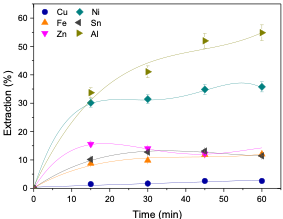- Alzate, A., López, E., Serna, C., Holuszko, M.E. and González, O. (2017). A systematic experimental study on gold recovery from electronic waste using selective ammonium persulfate oxidation. Vancouver B. C: 56th Conference of Metallurgist 2017. https://doi.org/10.14288/1.0347214.
- Anzures, N.J., Lopez-Sesenes, R., Larios-Gálvez, A.K., Vazquez-Velez, E., Uruchurtu-Chavarin, J. and Gonzalez-Rodríguez, J.G. (2022). Corrosion inhibition of aluminum 2024-T3 in 3.5% NaCl by using litchi chinensis extract.Revista Mexicana de Ingeniería Química 21, Mat2504. https://doi.org/10.24275/rmiq/Mat2504.
- Calla, D., Nava, F. and Fuentes, J.C. (2016). Acid decomposition and thiourea leaching of silver from hazardous jarosite residues: effect of some cations on the stability of the thiourea system. Journal Hazardous Materials 317, 440–448. https://doi.org/10.1016/j. jhazmat.2016.05.085.
- Calla, D. and Nava, F. (2020). Thiourea determination for the precious metals leaching process by iodate titration. Revista Mexicana de Ingeniería Química 19, 275–284. https://doi.org/10.242475/rmiq/IA539.
- Doona, C. and Stanbury, D.M. (1996). Equilibrium and redox kinetics of copper (II)-thiourea complexes. Inorganic Chemistry 35, 3210-3216.
- Free, M. (2013). Hydrometallurgy: Fundamentals and Applications. Editorial Wiley, United States of America.
- Jeon, S., Ito, M., Tabelin, C.B., Pongsumrankul, S.T., Kitajima, N., Saito, A., Park, I. and Hiroyoshi, N. (2019). A physical separation scheme to improve ammonium thiosulfate leaching of gold by separation of base metals in crushed mobile phones. Mineral Engineering 138, 168-177. http://doi.org/10.1016/j.mineng.201904.025.
- Jung, M., Yoo, K. and Alorro, R.D. (2017). Dismantling of electric and electronic components from waste printed circuit boards by hydrochloric acid leaching with stannic ions. Materials Transitions 58, 1076–1080. https://doi.org/10.2320/matertrans.M2017096.
- Kenna, C. (1991). Extraction and recovery of gold. In: US Patent, 5,260,040.
- Li, H., Eksteen, J., and Oraby, E. (2018). Hydrometallurgical recovery of metals from printed circuit boards (WPCBs): Current status and perspectives-A review. Resources, Conservation and Recycling 139, 122-139. https://doi.org/10.1016/j.resconrec.2018.08.007.
- Lothenbach, B., Ochs, M. and Hans, W. (1999). Thermodynamic Data for the Speciation and Solubility of Pd, Pb, Sn, Sb, Nb, and Bi in Aqueous Solution. Japan Nuclear Cycle Development Institute, Maramatsu, Naka-gun, Ibaraki, 319-1194. Report # JNC-TN– 8400-99-011.
- Moyo, T., Jiménez, F., Prestele, M., Kondo, T. and Petersen, J. (2022). Evaluating pre-treatment methods to maximise copper recovery from printed circuit boards. Journal of Metallurgy and Materials Science 64, 1-2.
- NIST: National Institute of Standards and Technology (2004). Database 46.8, Critically Selected Stability Constants of Metal Complexes. Version 8.0.
- Puigdomenech, I. (2004). Equilibrium Diagrams Using Sophisticated Algorithms (MEDUSA). Inorganic Chemistry. Royal Institute of Technology. https://sites.google. com/site/chemdiagr/.
- Rao, M.D., Singh, K.K., Morrison, C.A and Love, J.B. (2020). Challenges and opportunities in the recovery of gold from electronic waste. Royal Society of Chemistry Advances 10, 4300. https://doi.org/10.1039/c9ra07607g.
- Ruiz-Vela, J.I., Rodríguez-Vázquez E.E., Gudiño-Pérez, Y., Sánchez-Ramírez, R. and Montes-Rodríguez, J.J. (2023). Effect of complexing/buffering agent on the characteristics of a high phosphorous electroless nickel coating. Revista Mexicana de Ingeniería Química 22(2), Proc2331. https://doi.org/10.24275/rmiq/Proc2331.
- Segura, B. (2022). Lixiviación y recuperación de cobre y oro de basura electrónica mediante la utilización de agentes enmascarantes. Tesis de Doctorado en Ingeniería Química, Universidad Autónoma Metropolitana Unidad Iztapalapa, México.
- Segura, B. and Lapidus, G. (2023). Selective leaching of base/precious metals from E-waste of cellphone printed circuit boards (EWPCB): Advantages and challenges in a case study. Hydrometallurgy 217, 106040.https://doi.org/10.1016/j.hydromet.2023.106040.
- Segura, B. and Lapidus, G. (2021). Selective recovery of copper contained in waste PCBs from cellphones with impurity inhibition in the citrate-phosphate system. Hydrometallurgy 203, 105699. https://doi.org/10.1016/j.hydromet.2021.105699
- Smith, R. M. and Martell, A. E. (1982). Critical Stability Constants, vol 5: Organic and Inorganic Complex, Plenum Press, New York.
- Valix, M., Loo, Y.S., Bucknell, J., Cheung, A.W.H. and Hong, Y. (2017). Effect of FR-4 decomposition in the hydrometallurgical recovery of copper from electronic waste. Hydrometallurgy 173, 199–209. https://doi.org/10.1016/j.hydromet.2017.08.012.
- Xu, Y., Li, J. and Liu, L. (2016). Current status and future perspective of recycling copper by hydrometallurgy from waste printed circuit boards. Procedia Environmental Sciences 31, 162-170. https://doi.org/10.1016/j.proenv.2016.02.022.
|

